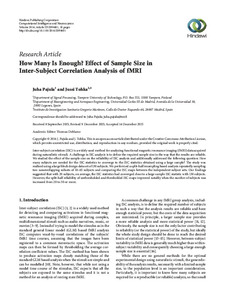How Many Is Enough? Effect of Sample Size in Inter-Subject Correlation Analysis of fMRI
Pajula, Juha; Tohka, Jussi (2016)
Pajula, Juha
Tohka, Jussi
2016
2094601
Julkaisun pysyvä osoite on
https://urn.fi/URN:NBN:fi:tty-201604293890
https://urn.fi/URN:NBN:fi:tty-201604293890
Kuvaus
Peer reviewed
Tiivistelmä
Inter-subject correlation (ISC) is a widely used method for analyzing functional magnetic resonance imaging (fMRI) data acquired during naturalistic stimuli. A challenge in ISC analysis is to define the required sample size in the way that the results are reliable. We studied the effect of the sample size on the reliability of ISC analysis and additionally addressed the following question: How many subjects are needed for the ISC statistics to converge to the ISC statistics obtained using a large sample? The study was realized using a large block design data set of 130 subjects. We performed a split-half resampling based analysis repeatedly sampling two nonoverlapping subsets of 10-65 subjects and comparing the ISC maps between the independent subject sets. Our findings suggested that with 20 subjects, on average, the ISC statistics had converged close to a large sample ISC statistic with 130 subjects. However, the split-half reliability of unthresholded and thresholded ISC maps improved notably when the number of subjects was increased from 20 to 30 or more.
Kokoelmat
- TUNICRIS-julkaisut [16983]
